The MSI Prestige 14 Evo Review: Testing The Waters Of Tiger Lake
by Brett Howse on December 17, 2020 10:00 AM EST- Posted in
- Laptops
- Intel
- MSI
- Tiger Lake
- Notebook
System Performance
Powered by the latest Intel Core i7-1185G7 processor, the MSI Prestige 14 is our first look at Tiger Lake in a production device. Intel’s Ice Lake platform was a strong step forward, with a new process and a new microarchitecture, and Tiger Lake looks to improve on that with a tweaked CPU core, improved frequencies thanks to the improved 10 nm Superfin process, and perhaps most importantly, Intel’s new Xe graphics in Tiger Lake promise a big step forward in terms of integrated graphics performance.
The Core-i7-1185G7 features four Willow Cove cores, with a peak single-core Turbo frequency of 4.8 GHz. This alone is a big jump over the Core i7-1065G7, which topped out at just 3.9 GHz. The CPU is fed by LPDDR4X-4267 memory as well, which is an improvement over the last generation of devices. The new Tiger Lake platform also adds support for not just Thunderbolt 4, but also PCIe 4.0, meaning faster storage is available.
While Intel has certainly struggled over the last several years, the company does seem to be moving in the right direction again, albeit not as quickly as they would probably prefer. Let’s dig into this new Tiger Lake platform and see how it performs. As a reminder, you can use our Online Bench to compare the MSI Prestige 14 Evo to any other laptop we’ve ever tested.
PCMark

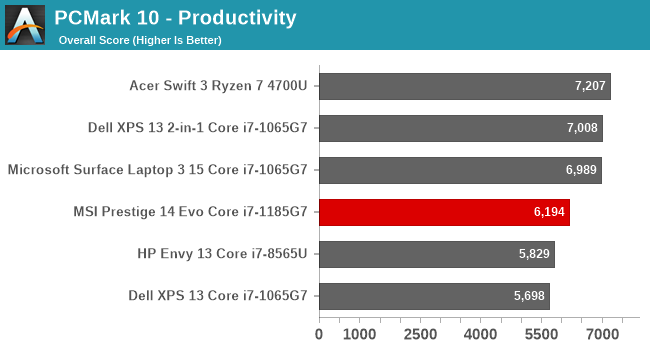
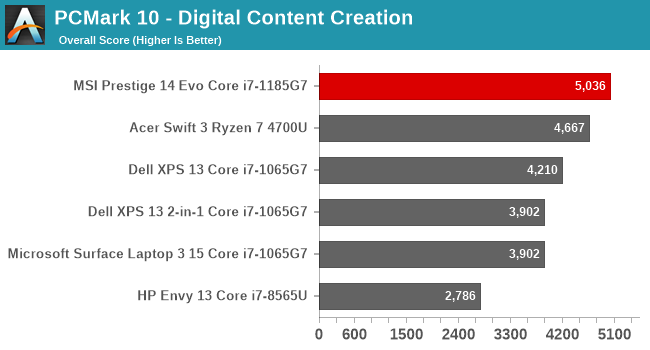
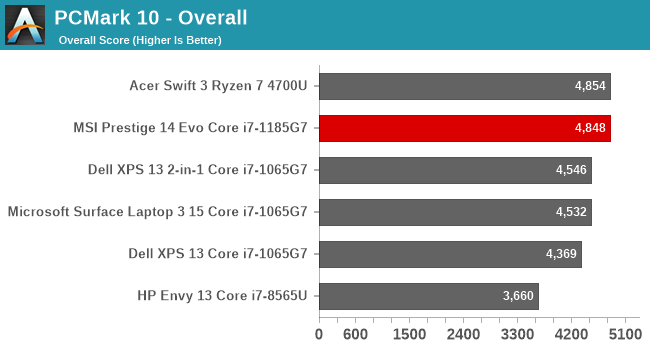
UL’s PCMark tests all aspects of a system, from CPU and GPU performance, to memory and storage, with several test suites focusing on different use cases, and using real-world applications such as web, video chat, and gaming. The MSI Prestige 14 performs very well here thanks to the improved Willow Cove CPU and the new Xe graphics.
Cinebench
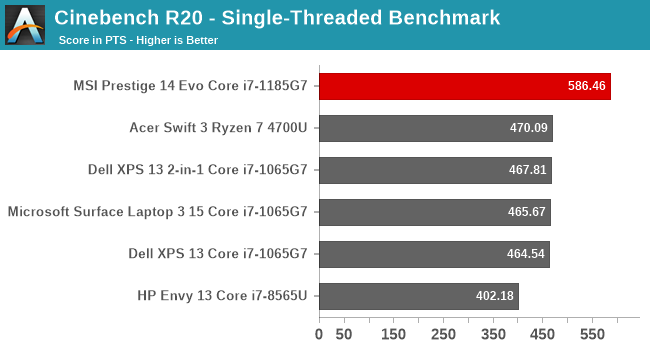
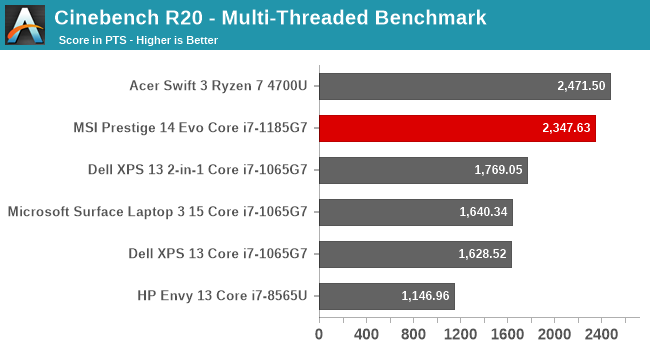
Although version R23 has just been released, for now we’ll continue to showcase R20 scores until we have enough R23 results for comparisons. The higher-frequency Tiger Lake design makes a large jump in single-threaded performance, easily surpassing the other laptop processors. On multi-thread, the quad-core i7 offers eight threads thanks to SMT, and scores very close to an eight-core Ryzen 7 4700U. Tiger Lake makes a big jump here compared to Ice Lake.
Handbrake
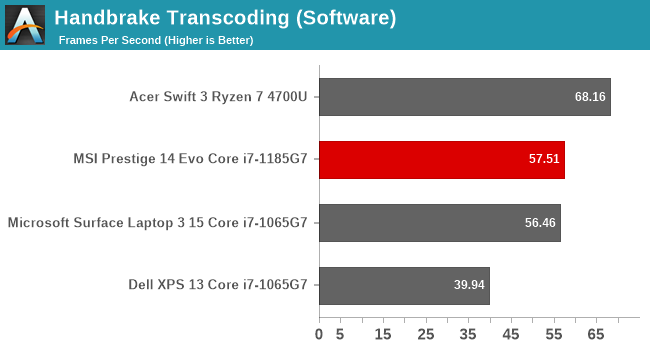
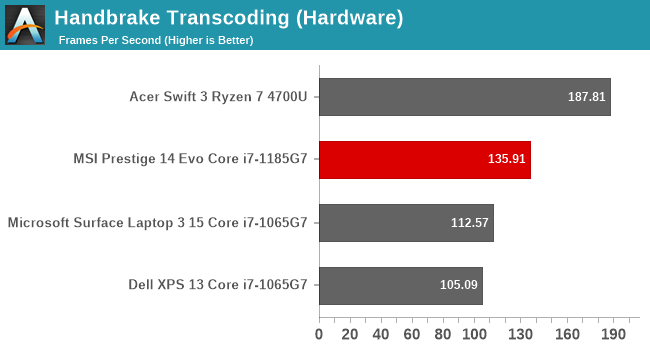
For video transcoding, Handbrake is likely the most popular solution. It offers both software transcoding done on the CPU, as well as hardware transcoding, which in the case of an Intel processor is Intel’s QuickSync media block. Somewhat surprisingly, the software transcode was not really much faster on the new Tiger Lake than it was on Ice Lake, but the hardware transcode did gain over the older design. It still can’t quite match Renoir though on software or hardware transcoding.
7-Zip
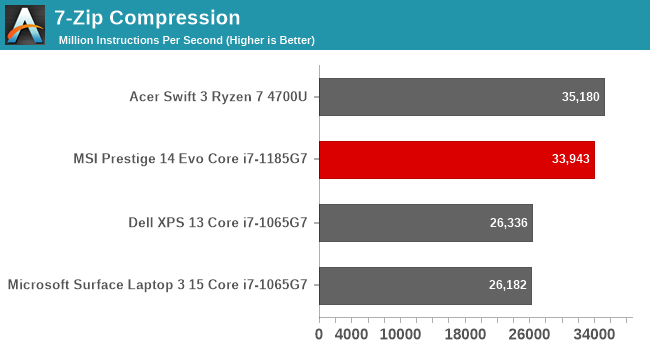
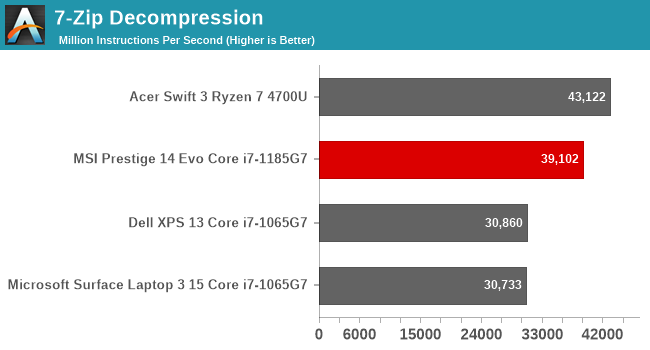
The open source file compression utility 7-Zip includes a built-in benchmark. The gains Intel has made over Ice Lake show up again here, with a strong win over last year’s i7 laptops. The eight cores on the Ryzen 7 4700U though are well-utilized here, and Tiger Lake can’t quite catch up with just four cores.
Web Performance
For 2020, we have moved to the new Chromium Edge on Windows 10 for all web testing. As much of the performance of the web can be tied to the underlying browser, consistency is key, and we found the Chromium Edge was one of the best performing browsers on Windows.


The gains Tiger Lake has made over Ice Lake on web performance are significant, and the higher frequency of the i7-1185G7 really makes a big difference here. The gains in Speedometer 2.0 are very impressive.
Storage Performance
Tiger Lake is the first platform from Intel to offer PCIe 4.0 support, which, at least for now, is mostly tied to faster storage. MSI has tapped the Phison PS5016-E16 SSD controller in both 512 GB and 1 TB size offerings, with the review unit being the smaller 512 GB model.
For 2020, we’ve moved to utilizing the PCMark Storage tests, which utilize real-world application traces for programs such as Adobe CC, and common tasks like booting Windows. The benchmark records bandwidth and access time, and calculates an overall score.

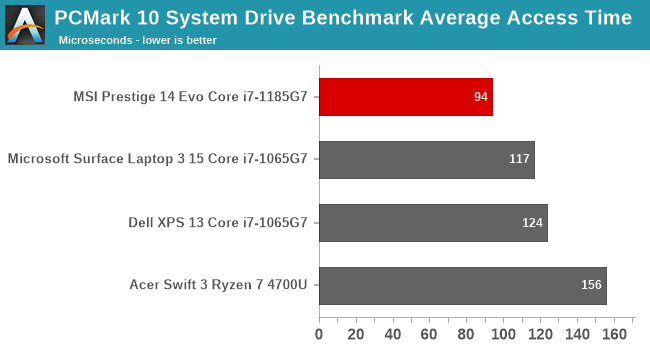
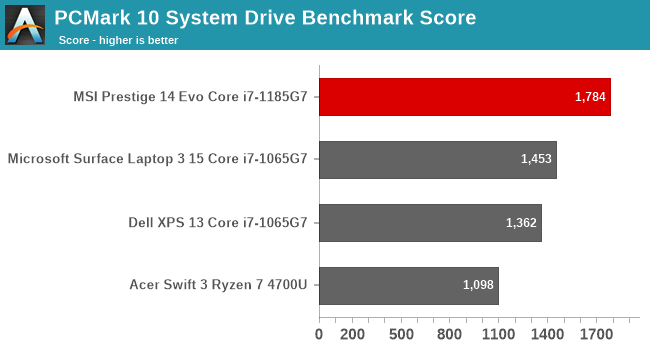
The new PCIe 4.0 drive is the top performing laptop drive we’ve tested yet. The results are not wildly higher than the PCIe 3.0 drives tested in the past, but that is to be expected for most actual storage tasks, and unless you are doing a lot of large file copies, the extra performance is noticeable, but not as big of a jump as going from SATA SSDs to NVMe would have been.











63 Comments
View All Comments
zodiacfml - Thursday, December 17, 2020 - link
Can't read this. Why would one consider this unless one doesn't know of ASUS' Zephyrus G14 lineup?JfromImaginstuff - Friday, December 18, 2020 - link
Short answer: businessRookierookie - Monday, December 21, 2020 - link
1. The G14 is considerably heavier and thicker2. The G14 doesn't have a webcam or card reader
3. The G14 doesn't have Thunderbolt
4. The G14 doesn't have dedicated navigation keys
If you don't need a gaming laptop, the better question is, why would one consider the Zephyrus G14?
mikk - Thursday, December 17, 2020 - link
Handbrake Transcoding (Hardware): the tester has zero clue about what he is doing. Is he testing the FF/low power or the much slower Hybrid of Quicksync and what target usage did he use: quality, balanced or speed. The fully fixed function encode is really fast on Tigerlake. Pretty sure he did use the slow Hybrid+quality/balanced encode.lmcd - Friday, December 18, 2020 - link
The quality levels on fully fixed function encode are NOT uniform across vendors and is useless as a benchmark.mikk - Friday, December 18, 2020 - link
The main problem is that he most likely didn't use the fully fixed function encode mode from Tigerlake, the performance gap would be much bigger to the software version and most likely he is comparing the fixed function of Renoir against Hybrid from Tigerlake. Without any infos about the encode settings this is an useless benchmark. And even for the software version, no info what x264/x265 preset he did use. This is not a good test.Spunjji - Friday, December 18, 2020 - link
"most likely he is comparing the fixed function of Renoir against Hybrid from Tigerlake"What's your basis for making that claim?
watzupken - Thursday, December 17, 2020 - link
I feel this is where testing of laptop is very tricky because of the many variables that will affect performance. This MSI laptop is probably one of the best Tiger Lake implementation out there for sure just by virtue of the performance. But the performance of laptops with Tiger Lake CPUs vary widely (I guess it is not just a problem with Tiger Lake, but across any CPU used) depending on how aggressive is the power setting, and how well they implement cooling. Also, comparing it with the Acer Swift 3 with a Ryzen 7 4700U may not be the best idea considering its almost an entry level laptop, just a notch above the even more budget Aspire series. So I expect the parts/ components and cooling to be inferior to the Prestige 14 Evo which will affect performance results across the board.Spunjji - Friday, December 18, 2020 - link
This is a fair point. The Swift 3 has been shown a few times to be a fairly poor showing for the Ryzen 7 4700U, whereas this implementation is one of the best for Tiger Lake. Most devices with TGL do not hit these performance levels, let alone sustain them.Of course, that's a problem for platform comparison - for comparing the actual devices available to consumers, it's fair to show how close the cheaper devices can get to the performance of a premium device.
hubick - Thursday, December 17, 2020 - link
I knew I wanted Tiger Lake w two Thunderbolt 4 ports and Xe graphics (not discrete, for Linux compat), and was seriously looking at this, but ended up ordering a Razer Book 13 instead. The Razer looks a little more well made plus has vapour chamber cooling.When I was researching, I tried using MSI's online chat to ask if this had eGPU support over Thunderbolt, and the rep connected, but never responded after 30 minutes, and then "hung up" on me. I figured if that was what I should expect from MSI support, best to stay away. Not that I have any faith in *any* company to provide decent support anymore *sigh*.